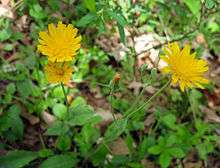Krigia biflora
| Krigia biflora | |
|---|---|
 | |
| Scientific classification | |
| Kingdom: | Plantae |
| (unranked): | Angiosperms |
| (unranked): | Eudicots |
| (unranked): | Asterids |
| Order: | Asterales |
| Family: | Asteraceae |
| Genus: | Krigia |
| Species: | K. biflora |
| Binomial name | |
| Krigia biflora (Walter) S.F.Blake 1915 | |
| Synonyms[1] | |
| |
Krigia biflora, also known as two-flower cynthia or two-flower dwarf dandelion, is a North American species of plants in the sunflower family . It is native to central Canada (Manitoba and Ontario) and to the eastern, central, and southwestern United States.[2][3] Two-flowered Cynthia is rare in Connecticut, and it is listed as a species of special concern.[4]
Krigia biflora is an erect perennial growing 18 to 32 inches (450–800 mm) tall. One plant can have 20 or more flower heads, very often 2 per flower stalk, each head with 25-60 yellow to orange-yellow ray flowers about 1 to 1.5 inches (25–38 mm) across. There are no disc flowers. It can become an invasive plant. It grows in a variety of habitats and soils and blooms in late Spring to late Summer. The name of the plant consists of two words: Krigia for David Krieg, the German physician who first collected this plant in Maryland; and biflora, meaning two-flowered.[5][6]
References
- ↑ The Plant List, Krigia biflora (Walter) S.F.Blake
- ↑ United States Department of Agriculture plants profile
- ↑ Biota of North America Program 2014 county distribution map
- ↑ Connecticut Botanical Society
- ↑ Wisconsin Plants
- ↑ Flora of North America, Krigia biflora (Walter) S. F. Blake, 1915. Orange dwarfdandelion